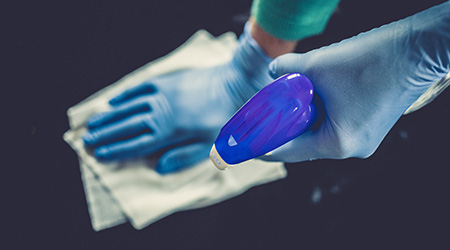On April 5, 2021, the U.S. Centers for Disease Control and Prevention issued an update stating, “The principal mode by which people are infected with SARS-CoV-2 (the virus that causes COVID-19) is through exposure to respiratory droplets carrying infectious virus. It is possible for people to be infected through contact with contaminated surfaces or objects (fomites), but the risk is generally considered to be low.”
While the coronavirus might not be easily transmitted via fomites according to the CDC bulletin, other pathogenic organisms are. Facility staff, including environmental services teams, shouldn’t neglect the proper cleaning and disinfection of these sites.
Unlike viruses and bacteria, deadly fungal infections such as Candida auris are not easily treated. There are only five classes of antifungal drugs, a small number compared with the more than 20 classes of antibiotics to fight bacteria. Antifungal medications are so few in part because they are difficult to design. Fungi and humans are similar at the cellular level. It is challenging to create a drug that can kill fungi without killing us, too.
In the 16 months since COVID-19 became the central focus of America, EPA’s List N has grown to 560 disinfectants with this notation: “Kills a harder-to-kill pathogen than SARS-CoV-2 (COVID-19); Emerging viral pathogen claim.” This sounds like good news. So, why is this actually a problem?
While we were concerned about making surfaces safe from COVID, Candida auris was quietly killing people and raising red flags at the CDC. While COVID patients were clinging to life in an intensive care unit being treated with heavy duty antibiotics, the professional cleaning staff, unaware of the fungus, was disinfecting hospital surfaces with disinfectants on List N and merely spreading the fungus from one surface to the next without killing it. But that is not their fault.
Now that we are aware of the problem, what disinfectant should be used to kill C. auris on surfaces?
On Feb. 12, 2020, the U.S. Environmental Protection Agency (EPA) announced the availability of 11 products that have been approved for use to disinfect surfaces against the emerging multidrug-resistant fungus C. auris.
The EPA-registered disinfectants for use against C. auris in early 2020 are:
- Avert Sporicidal Disinfectant Cleaner (EPA Reg. No. 70627-72);
- Blondie (EPA Reg. No. 67619-24);
- Dagwood (EPA Reg. No. 67619-25);
- Micro-Kill Bleach Germicidal Bleach Wipes (EPA Reg. No. 37549-1);
- Oxivir 1 (EPA Reg. No. 70627-74);
- Oxivir 1 Wipes (EPA Reg. No. 70627-77);
- Oxivir Wipes (EPA Reg. No. 70627-60);
- Oxycide Daily Disinfectant Cleaner (EPA Reg. No. 1677-237);
- Virasept (EPA Reg. No. 1677-226);
- >Wonder Woman Formula B Germicidal Wipes (EPA Reg. No. 9480-12); and
- Wonder Woman Formula B Spray (EPA Reg. No. 9480-10).
Because there are few products with C. auris claims at this time, the CDC and the EPA have identified additional products that are effective against the fungus. Although these products do not yet have formal EPA-registered claims for C. auris, testing at CDC has confirmed they are effective against C. auris. The label on the product will not include instructions for the superbug. CDC guidance states to “follow the instructions provided for C. albicans, if included, or else follow those for fungicidal activity.” These products include:
- Oxivir TB Spray (EPA Reg. No. 70627-56); and
- PDI Super Sani-Cloth (EPA Reg. No. 9480-4).
The CDC Guidance further states that, if none of the above-listed products are available, or any of the EPA-registered products that are newly approved for the specific claims against C. auris, CDC recommends use of an EPA-registered hospital-grade disinfectant from List K (effective against C-difficile spores). The CDC believes these products have been used effectively against C. auris.
J. Darrel Hicks, BA, MESRE, CHESP, Certificate of Mastery in Infection Prevention is the Past President of the Healthcare Surfaces Institute. Hicks is nationally recognized as a subject matter expert in infection prevention and control as it relates to cleaning. He is the owner/principal of Safe, Clean and Disinfected. His enterprise specializes in B2B consulting, webinar presentations, seminars and facility consulting services related to cleaning and disinfection. He can be reached at darrel@darrelhicks.com or you can learn more at www.darrelhicks.com.

 Grounding Healthcare Spaces in Hospitality Principles
Grounding Healthcare Spaces in Hospitality Principles UC Davis Health Selects Rudolph and Sletten for Central Utility Plant Expansion
UC Davis Health Selects Rudolph and Sletten for Central Utility Plant Expansion Cape Cod Healthcare Opens Upper 2 Floors of Edwin Barbey Patient Care Pavilion
Cape Cod Healthcare Opens Upper 2 Floors of Edwin Barbey Patient Care Pavilion Building Sustainable Healthcare for an Aging Population
Building Sustainable Healthcare for an Aging Population Froedtert ThedaCare Announces Opening of ThedaCare Medical Center-Oshkosh
Froedtert ThedaCare Announces Opening of ThedaCare Medical Center-Oshkosh